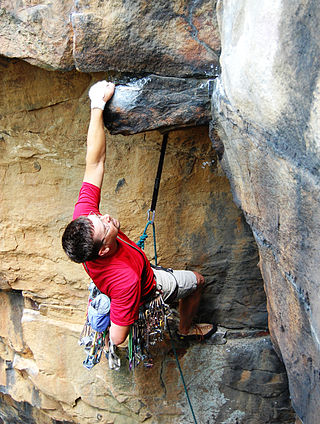
Traditional climbing is a type of free climbing in rock climbing where the lead climber places the protection equipment while ascending the route; when the lead climber has completed the route, the second climber then removes the protection equipment as they climb the route. Traditional climbing differs from sport climbing where the protection equipment is pre-drilled into the rock in the form of bolts.

A climbing route is a path by which a climber reaches the top of a mountain, or rock/ice-covered obstacle. The details of a climbing route are recorded in a climbing guidebook and/or in an online climbing route database, and will include elements such as the type of climbing route, the difficulty grade of the route–and beta on its crux(es)–and any risk or commitment grade, the length and number of pitches of the route, and the climbing equipment needed to complete the route.
Glossary of climbing terms relates to rock climbing, mountaineering, and to ice climbing.

In mountaineering and climbing, a first ascent, is the first successful documented climb to the top of a mountain or the top of a particular climbing route. Early 20th-century mountaineers and climbers focused on reaching the tops of iconic mountains and climbing routes by whatever means possible, often using considerable amounts of aid climbing, and/or with large expedition style support teams that laid "siege" to the climb.

Action Directe is a short 15-metre (49 ft) sport climb at the limestone Waldkopf crag in Frankenjura, Germany. When it was first climbed by German climber Wolfgang Güllich in 1991, it became the first climb in the world to have a consensus 9a (5.14d) grade. Action Directe is considered an important route in rock climbing history, and is one of the most attempted climbs at its grade, where it is considered the "benchmark" for the level of 9a. The plyometric training techniques and customized equipment that Güllich used to prepare for the unique physical demands of Action Directe also revolutionized climbing and what could be achieved.

Free climbing is a form of rock climbing in which the climber can only use climbing equipment for climbing protection but not as an artificial aid to help them in ascending the route. Free climbing, therefore, cannot use any of the tools that are used in aid climbing to help overcome the obstacles encountered while ascending a route. The development of free climbing was an important moment in the history of rock climbing, including the concept and definition of what determined a first free ascent of a route by a climber.
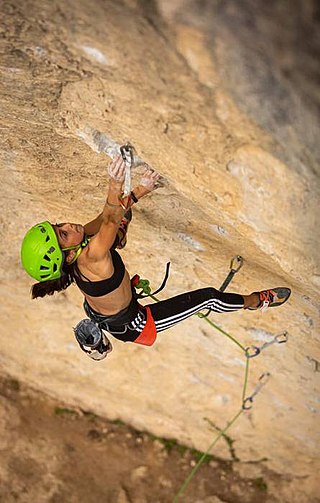
Lead climbing is a technique in rock climbing where the 'lead climber' clips their rope to the climbing protection as they ascend a pitch of the climbing route, while their 'second' remains at the base of the route belaying the rope to protect the 'lead climber' in the event that they fall. The term is used to distinguish between the two roles, and the greater effort and increased risk, of the role of the 'lead climber'.

Chris Omprakash Sharma is an American rock climber who is considered one of the greatest and most influential climbers in the history of the sport. He dominated sport climbing for the decade after his 2001 ascent of Realization/Biographie, the world's first-ever redpoint of a consensus 9a+ (5.15a) graded route, and ushered in what was called a "technical evolution" in the sport. Sharma carried the mantle of "world's strongest sport climber" from Wolfgang Güllich, and passed it to Adam Ondra.
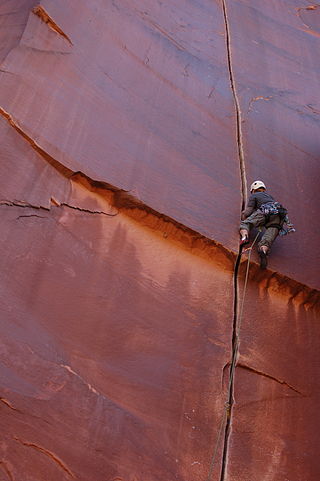
Rock climbing is a climbing sports discipline that involves ascending routes consisting of natural rock in the outdoor environment and on artificial resin climbing walls in a mostly indoor environment. Routes are chronicled in guidebooks, and on online databases, with the details of how to climb the route, and who made the first ascent and the coveted first free ascent. Climbers will try to ascend a route onsight, however, a climber can spend years projecting a route before they make a redpoint ascent.
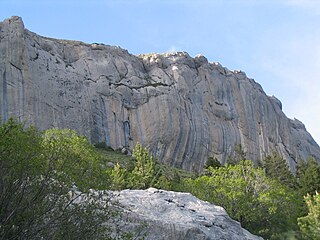
Realization, also called Biographie, is a circa 35-metre (115 ft) sport climbing route on a limestone cliff on the southern face of Céüse mountain, near Gap and Sigoyer, in France. After it was first climbed in 2001 by American climber Chris Sharma, it became the first rock climb in the world to have a consensus grade of 9a+ (5.15a). It is considered an historic and important route in rock climbing, and one of the most attempted climbs at its grade.
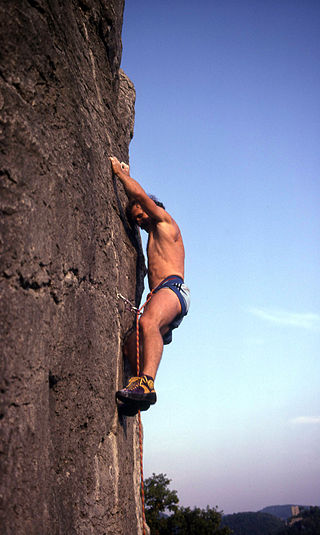
In rock climbing, redpointing means to free-climb a climbing route from the ground to the top while lead climbing, after having practiced the route or after having failed the first attempt. Climbers will try to redpoint a route after having failed to onsight it, or flash it. The first successful redpoint of a route, in the absence of any prior onsight or flash, is recorded as the first free ascent (FFA) of that route.

In the history of rock climbing, the three main sub-disciplines – bouldering, single-pitch climbing, and big wall climbing – can trace their origins to late 19th-century Europe. Bouldering started in Fontainebleau, and was advanced by Pierre Allain in the 1930s, and John Gill in the 1950s. Big wall climbing started in the Dolomites, and was spread across the Alps in the 1930s by climbers such as Emilio Comici and Riccardo Cassin, and in the 1950s by Walter Bonatti, before reaching Yosemite where it was led in the 1950s to 1970s by climbers such as Royal Robbins. Single-pitch climbing started pre-1900 in both the Lake District and in Saxony, and by the late-1970s had spread widely with climbers such as Ron Fawcett (Britain), Bernd Arnold (Germany), Patrick Berhault (France), Ron Kauk and John Bachar (USA).

Adam Ondra is a Czech professional rock climber, specializing in lead climbing, bouldering, and competition climbing. In 2013, Rock & Ice described Ondra as a prodigy and the leading climber of his generation. Ondra is the only male athlete to have won World Championship titles in both disciplines in the same year (2014) and is one of the two male athletes to have won the World Cup series in both disciplines.

La Rambla is a 41-metre (135 ft) sport climb at the limestone El Pati crag in Siurana, Catalonia in Spain. Originally bolted and climbed by Alexander Huber in 1994 as a 35-metre (115 ft) route, the bolting was later extended by Dani Andrada to a 41-metre (135 ft) route, which was eventually climbed by Ramón Julián Puigblanque in 2003. While there has been debate about La Rambla's grade, there is now consensus that it meets the 9a+ (5.15a) threshold. It is an important and historic route in climbing, and is part of the coveted "9a+ trilogy" with Realization and Papichulo.

Alexander Megos is a German rock climber specializing in sport climbing, bouldering and competition climbing. In 2013, he became the first-ever climber to onsight a 9a (5.14d) graded route. He has made the first free ascent (FFA) of some of the hardest sport climbing routes in the world, including two 9b+ (5.15c) routes, four 9b (5.15b) routes, and several boulders with a boulder 8C (V15) rating.

La Dura Dura is a 50-metre (160 ft) sport climbing route on the multi-coloured limestone cliffs known as the Contrafort de Rumbau, which are part of the Roc de Rumbau mountain, that lies in Oliana, Spain. The route was bolted and developed by American climber Chris Sharma in 2009 who had almost given up believing he could climb it until a collaboration with Czech climber Adam Ondra led to Ondra climbing the route on 7 February 2013, followed by Sharma on 23 March 2013.

Stefano Ghisolfi is an Italian professional rock climber, who specializes in competition climbing, sport climbing, and bouldering. In competition climbing, he completes in competition lead climbing, competition bouldering, and competition speed climbing, with lead being his strongest discipline. As a sport climber, he has redpointed sport climbing routes of grade 9b+ (5.15c), onsighted routes of 8c (5.14b), and solved boulder problems at grade 8B+ (V14). In December 2018, after climbing Perfecto Mundo, he became the fourth climber in history to redpoint a 9b+ (5.15c) route.

Laura Rogora is an Italian rock climber who specializes in sport climbing and in competition climbing. In 2021, she became the third-ever female climber in history to redpoint a 9b (5.15b)-graded sport climbing route, with her ascent of Erebor in Italy.

Hubble is a short 10-metre (33 ft) bolted sport climb at the limestone crag of Raven Tor in Millers Dale, in the Peak District in Derbyshire, England. When Hubble was first redpointed by English climber Ben Moon on 14 June 1990, it became the first-ever climb in the world to have a consensus climbing grade of 8c+ (5.14c); and the highest grade in the English system at E9 7b.






![Ainhize Belar [eu] on Gezurren Erresuma (grade 8c, 5.14b, XI-), in Spain. Ainhize Belar eskalatzen.jpg](http://upload.wikimedia.org/wikipedia/commons/thumb/c/c8/Ainhize_Belar_eskalatzen.jpg/180px-Ainhize_Belar_eskalatzen.jpg)























